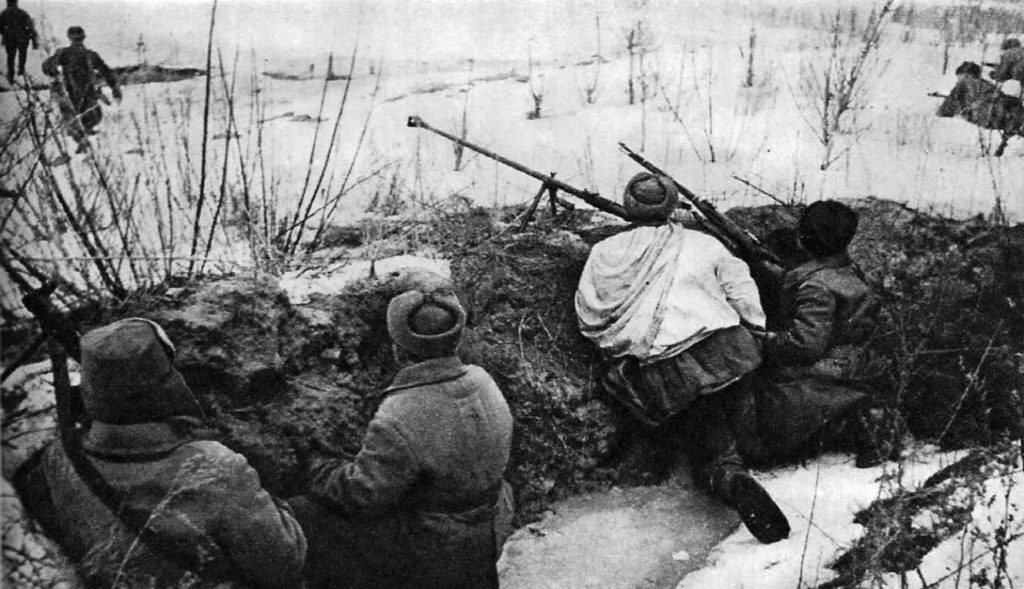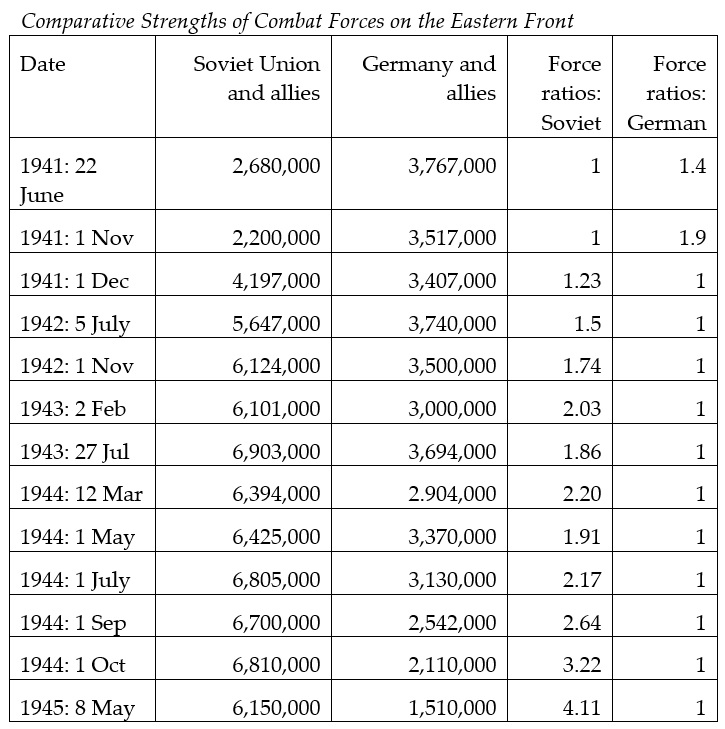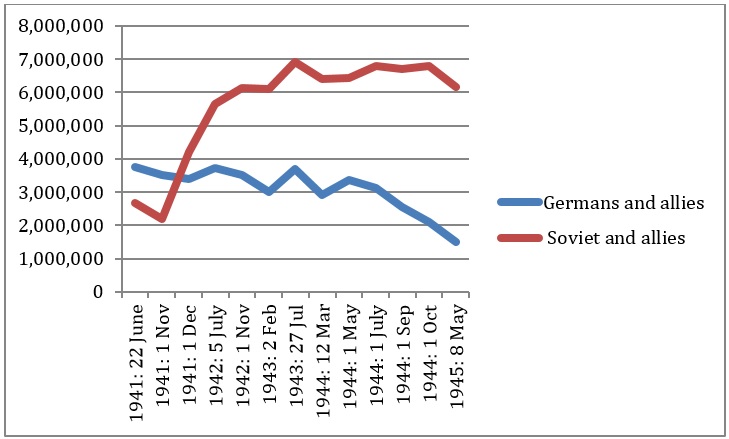Was the Russian Military a Steamroller? From World War II to Today

Joseph Stalin supposedly claimed that “quantity has a quality all its own,” justifying a cannon-fodder mentality and immense casualties. The problem is, Stalin never actually said that, but it fits our stereotype about the Russian military so neatly that everyone believes he did.
When it comes to war, Russia is commonly perceived as favoring quantity over quality and winning mainly by overwhelming its opponents with hordes of poorly trained soldiers. You can hardly find any account of Russia’s wars that does not use terms like “hordes,” “masses,” and even “Neolithic swarms.” Quantity, it is believed, made quality almost irrelevant.
German generals propagated the myth of a Red Army comprised of faceless masses of troops, motivated only by NKVD rifles at their backs and winning only through sheer force of numbers. Many Western histories accept this view, and it is standard fare in Hollywood, notably in the 2001 Enemy at the Gates. The story was also standard fare during the Cold War, when the intelligence community frequently overestimated the quantitative side of Soviet capabilities while belittling its quality.
True, some analysts argued for a more nuanced approach. For instance, Michael Handel in 1981 wrote that “To claim that the USSR is emphasizing quantity over quality in military equipment is to foster a dangerous misconception” [emphasis in the original]. We also know that the “missile gap” and “bomber gap” were artifacts of faulty intelligence analysis.
However, when you crunch the numbers, it turns out that Russian superiority has not been as great as most people believe. In fact during World War II, the U.S. Army often had about the same numerical advantage over its enemies as did the Red Army. A better understanding of the past might shift our perceptions of the present.
Force Ratios
Some German sources and popular histories claim that the Red Army outnumbered the Wehrmacht by ten to one or even twenty to one. The numbers do not support those claims. In When Titans Clashed: How the Red Army Stopped Hitler, David Glantz and Jonathan House provide authoritative data on ratios of active forces on the Eastern Front. This table offers a sample of that data:

The Red Army was outnumbered by Axis forces in 1941 at the beginning of Operation Barbarossa. Soviet mobilization efforts and steady German losses began to change the force ratios in 1942, but the Red Army only had a roughly 2:1 advantage from February 1943 until mid-1944 before maxing out at a little over 4: 1 at the very end of the war.
Here’s another way of looking at the force ratios. The Red Army in the field actually peaked in size in mid-1943, but the ratios continued to shift in its favor due to Germany’s inability to replace losses. The Red Army didn’t keep getting bigger, but it maintained its size while the Wehrmacht steadily lost ground, literally and figuratively.

A 2:1 advantage is significant, but falls short of the 3:1 force ratio that is generally regarded as necessary for attacking forces, and it’s a long way from the double-digit advantage that is often claimed. Both sides were able to temporarily achieve greater numerical advantages in certain times and places by concentrating forces.
What about force ratios at the Battle of Stalingrad, which has been the focus of so much attention? It turns out there are some surprises here, too. During the defensive phase of urban warfare (August through mid-November 1942), the Red Army was outnumbered about 1.6:1. The Red Army reversed the odds in its counteroffensive in November 1942, achieving about a 2:1 advantage during Operation Uranus.
Military Manpower
What’s interesting is that the Soviet Union was not able to draw on a bottomless well of recruits to achieve these ratios. The Soviet Union had a larger population than Germany in 1939 — about twice as large. But the Soviet Union that fought World War II was not the Soviet Union of 1939. In 1941 the Axis occupied about a third of Soviet territory where 45 percent of its population lived — nearly 90 million people out of 190 million. Some refugees fled the occupied zones. The best estimate is that 110 to 120 million people remained in the unoccupied areas of the Soviet Union. For nearly two years, the Soviets actually fought with a lower population base than the United States.

Brute Force: Not Just RussiaBy the end of the war, the United States and the Soviet Union actually had just about the same size total military forces (12 million) and the same size armies (6 million). However, the Soviets mobilized more troops during the course of the war, nearly twice as many. They fought longer and had to replace far more casualties. They did it by stripping the civilian and agricultural workforces, which dropped by 40 to 60 percent.
Americans and their British comrades like to believe that while they won World War II in Europe with finesse, while the Soviets won with overwhelming brute force, but that simply is not true. In 1990, John Ellis wrote Brute Force: Allied Strategy and Tactics in the Second World War in which he suggested that American, Russian, and British commanders alike “seemed unable to impose their will upon the enemy except by slowly and persistently battering him to death with a blunt instrument.”
Ellis detailed the advantages of the Allies. For example: once American troops began landing in North Africa in late 1942, the Allies quickly achieved rough parity with Axis forces, and by March 1943 had a 3:1 overall advantage in divisions in North Africa. The Allies had more divisions in Italy than the Axis from July 1943 until the end of the war, at times achieving a ratio there of 1.5:1.
The Allies achieved parity with Germany in number of divisions in Northwest Europe by September 1944. The ratio changed steadily in the Allies’ favor in 1945 to 2:1. At the Battle of the Bulge, the Allies were initially outnumbered nearly 1.8:1, but in less than ten days gained the upper hand in troops and a 4:1 advantage in tanks. Within the span of four weeks, the Allies reversed the troop ratio and attained an 11:1 advantage in tanks. The Allies also had quantitative superiority in the Pacific, where they had more divisions than the Japanese from late 1942 until the end of the war, achieving advantages of 1.5:1 in 1943, 2:1 in 1944, and 2.6:1 in mid-1945.
In short, the United States and the United Kingdom often had numerical superiority in World War II — and often in a similar ratio to that enjoyed by the Soviet Union.
Russia Today
In quantitative terms, Russia today is a shadow of its imperial and Soviet predecessors. Russia still has a lot of tanks — 15,000 to 8,000 for the United States, nearly a 2: 1 advantage. However, the United States has superiority over Russia in most other areas: total aircraft 3.8:1, total naval assets 1.2:1.
In nearly every arena, Russia is behind the United States and, often, many other states as well. The United States today has twice as many people. In fact, Indonesia, Brazil, Pakistan, Nigeria, and Bangladesh all have more people than Russia. Russia’s active military of 766,000 is barely larger than North Korea’s. The United States and India have nearly twice as many military personnel, and China has three times as many. China and the United Kingdom spend more on defense than does Russia. India and Japan’s military budgets are only slightly less than Russia’s. The United States far outstrips every other nation in military expenditures with a defense budget ten times greater than that of Russia.
Russia’s primary quantitative advantage today is real estate. Post-Soviet Russia is still the largest country in the world. But defending a country twice the size of the United States with half the population and half as large an army is not necessarily an advantage.
For these reasons, analysts like Timothy Thomas believe that Russia today is more likely to employ “indirect, asymmetric, and non-military measures” against its neighbors than to rely primarily on a quantitative advantage it would be hard-pressed to achieve.
Conclusions
Soviet numerical advantages in World War II were significant but not overwhelming. It rarely demonstrated the steamroller superiority of German myth and Hollywood hyperbole. When you crunch the numbers, it turns out that Russian superiority was not so great as is commonly believed.
The Red Army did attain numerical superiority on the Eastern Front. Slowly and at great cost, drawing on a smaller available population than that of the United States, it was able to gain a 2:1 advantage over the Axis by 1943 and a 4:1 edge in 1945. That’s a significant quantitative advantage, but not exactly a steamroller — and not much different from the brute force advantage the western Allies also enjoyed.
World War II has much to teach us. Debunking the myths of this war can improve our understanding of the military situation today. We might even avoid generating new myths based on old stereotypes.
Reina Pennington, PhD, teaches military and Russian history at Norwich University in Vermont. She is a former Air Force intelligence officer and Soviet analyst, and is presently working on a book entitled What Russia Can Teach Us About War.

